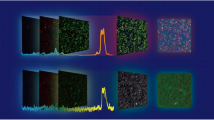Abstract
Pathology as a common diagnostic test of cancer is an invasive, time-consuming, and partially subjective method. Therefore, optical techniques, especially Raman spectroscopy, have attracted the attention of cancer diagnosis researchers. However, as Raman spectra contain numerous peaks involved in molecular bounds of the sample, finding the best features related to cancerous changes can improve the accuracy of diagnosis in this method. The present research attempted to improve the power of Raman-based cancer diagnosis by finding the best Raman features using the ACO algorithm. In the present research, 49 spectra were measured from normal, benign, and cancerous breast tissue samples using a 785-nm micro-Raman system. After preprocessing for removal of noise and background fluorescence, the intensity of 12 important Raman bands of the biological samples was extracted as features of each spectrum. Then, the ACO algorithm was applied to find the optimum features for diagnosis. As the results demonstrated, by selecting five features, the classification accuracy of the normal, benign, and cancerous groups increased by 14% and reached 87.7%. ACO feature selection can improve the diagnostic accuracy of Raman-based diagnostic models. In the present study, features corresponding to ν(C–C) αhelix proline, valine (910–940), νs(C–C) skeletal lipids (1110–1130), and δ(CH2)/δ(CH3) proteins (1445–1460) were selected as the best features in cancer diagnosis.



Similar content being viewed by others
References
Richards-Kortum R, Mahadevan-Jansen A, Ramanujam N (1996) Optical spectroscopy vs. the surgical suite [cancer detection]. IEEE Circuits and Devices Magazine 12:34–40
Santos IP et al (2017) Raman spectroscopy for cancer detection and cancer surgery guidance: translation to the clinics. Analyst 142(17):3025–3047. https://doi.org/10.1039/C7AN00957G
Mahadevan-Jansen A, Richards-Kortum RR (1996) Raman spectroscopy for the detection of cancers and precancers. J Biomed Opt 1:31–70
Raniero L et al (2011) In and ex vivo breast disease study by Raman spectroscopy. Theor Chem Accounts 130:1239–1247
Austin LA, Osseiran S, Evans CL (2016) Raman technologies in cancer diagnostics. Analyst 141:476–503
Wang W, Zhao J, Short M, Zeng H (2015) Real-time in vivo cancer diagnosis using raman spectroscopy. J Biophotonics 8(7):527–545
Lewis IR, Edwards H (2001) Handbook of Raman spectroscopy: from the research laboratory to the process line. CRC Press
Krishna H, Majumder SK, Gupta PK (2012) Range-independent background subtraction algorithm for recovery of Raman spectra of biological tissue. J Raman Spectrosc 43:1884–1894
Dehghani-Bidgoli Z, Baygi MHM, Kabir E, Malekfar R (2014) A comparative study between carcinoma and sarcoma using Raman spectroscopy. J Appl Spectrosc 80:893–898
Bergholt MS et al (2011) In vivo diagnosis of gastric cancer using Raman endoscopy and ant colony optimization techniques. Int J Cancer 128:2673–2680
Elbeltagi E, Hegazy T, Grierson D (2005) Comparison among five evolutionary-based optimization algorithms. Adv Eng Inform 19(1):43–53
Author information
Authors and Affiliations
Corresponding author
Ethics declarations
Ethical approval
All the procedures performed in the study involving human participants were in accordance with the ethical standards of the Islamic Azad University Research Committee as well as with the 1964 Helsinki declaration and its later amendments or comparable ethical standards.
Informed consent
Informed consent was obtained from all the participants included in the study.
Conflict of interest
The authors declare that they have no conflict of interest.
Rights and permissions
About this article
Cite this article
Fallahzadeh, O., Dehghani-Bidgoli, Z. & Assarian, M. Raman spectral feature selection using ant colony optimization for breast cancer diagnosis. Lasers Med Sci 33, 1799–1806 (2018). https://doi.org/10.1007/s10103-018-2544-3
Received:
Accepted:
Published:
Issue Date:
DOI: https://doi.org/10.1007/s10103-018-2544-3




